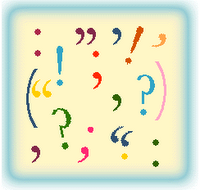Technical editor and yarncrafting expert Kj Hay joins us for a series on understanding the different elements of patterns. Click here to read her earlier blog posts.
 Punctuation differs from publisher to publisher, but in all cases is used to separate and group instructions. Typically, commas, semi-colons, colons, and dashes are used to separate. Parentheses, brackets, curly braces, and asterisks are used to group. Commas and semi-colons are used to separate each part of an instruction making the parts a bit easier to see and read.
Punctuation differs from publisher to publisher, but in all cases is used to separate and group instructions. Typically, commas, semi-colons, colons, and dashes are used to separate. Parentheses, brackets, curly braces, and asterisks are used to group. Commas and semi-colons are used to separate each part of an instruction making the parts a bit easier to see and read.
Instructions and parts of instructions are grouped for several reasons; 1) To indicate that multiple stitches are to be worked into the same location and, 2) To indicate that instructions are to be repeated.
Parentheses are most often used to group stitches to be worked into one location. For example, “(k1, p1, k1) in next st” indicates that all 3 stitches within the parentheses are to be worked into the next stitch before it is removed from the left needle. Brackets, curly braces, and asterisks paired with “repeat” are used most often to group instructions to be repeated.
Dashes, colons, or parentheses are often used at the end of an instruction to separate the stitch count from the rest of the instruction. A stitch count indicates the number of stitches worked in the row or round just completed. If no stitch count is given it usually means that the stitch count has not changed since the last time a stitch count was provided.
It’s a good idea to compare the number of stitches in the last row or round you worked with given stitch counts. To determine the number of stitches worked in the last row or round, count the number of loops remaining on the knitting needle or count the number of “V’s” visible when looking at the top of the last row or round of crochet. When counting the number of stitches in a joined round of crochet, take care not to count the “V” formed by the joining slip stitch.
Related links: